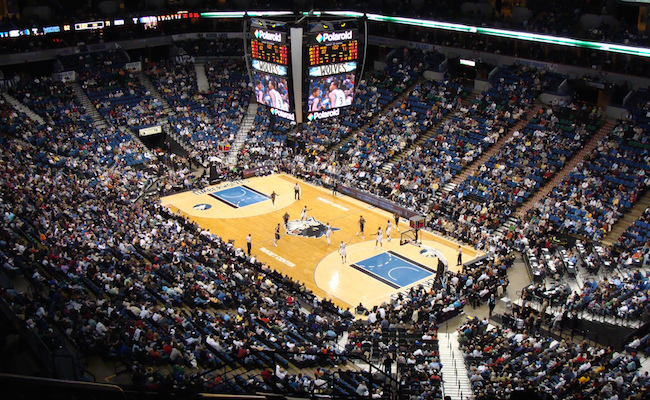
The reason Henry Abbott started writing a blog was simple: It seemed like the only viable route he had to being a sports writer.
 That was almost a decade ago. Now the founder of the NBA blog TrueHoop will be taking over the reins of basketball coverage on ESPN.com. Abbott’s ascent was a gradual one; after ESPN bought TrueHoop in 2007 it expanded the blog into a network of similarly inclined (analytical, passionate, bordering on obsessed) up and coming beat writers. Abbott’s story was an early version of one increasingly familiar in journalism today: the outsider brought in to help a media company build online savvy and reach new audiences. It’s also a formula that has worked well for ESPN, from Bill Simmons and Grantland to Nate Silver’s new FiveThirtyEight.
That was almost a decade ago. Now the founder of the NBA blog TrueHoop will be taking over the reins of basketball coverage on ESPN.com. Abbott’s ascent was a gradual one; after ESPN bought TrueHoop in 2007 it expanded the blog into a network of similarly inclined (analytical, passionate, bordering on obsessed) up and coming beat writers. Abbott’s story was an early version of one increasingly familiar in journalism today: the outsider brought in to help a media company build online savvy and reach new audiences. It’s also a formula that has worked well for ESPN, from Bill Simmons and Grantland to Nate Silver’s new FiveThirtyEight.
As the NBA deputy editor for ESPN.com, Abbott will have a different kind of task. Instead of building a new franchise from the ground up, he’ll have to apply lessons from TrueHoop to take ESPN’s NBA coverage in a new direction in order to meet fans needs — and better compete with the future TrueHoops of the world. Abbott’s excited about what comes next, but realistic about the challenges facing everyone in the media business. “All in all, I think the exciting and terrifying part of this is we really can’t do things the way they’ve always been done,” he told me.
In our conversation, we talked about how the path to becoming a sports writer has changed, what kind of coverage NBA fans expect, my poor Minnesota Timberwolves, and the rise of sports analytics. Here’s a lightly edited transcript of our conversation
I think we’re probably too distant from the players. Social media is making it clear players have all this infinite personality, and I think the audience wants it up close. They want to feel the character of the game too.
We’re trying to achieve all those things and how that’s best done is a process of experimentation for the next couple decades.
Blogging just let everybody who wanted to try it try it. And that was a subject of concern for a lot of people. I think most of the concern boiled down to “With no barrier to entry, do these people who are doing this have any reason to do this? Should we believe them and are they accurate?” I guess the answer is now all over the place.
The blogging that matters to me, that has at the forefront of the TrueHoop network, and that has launched a lot of careers over the last few years, is blogging where people are very scrupulous about being accurate. You can’t shoot from the hip and say, “This guy is a jerk.” You have to make evidence-based decisions. I think blogging has opened the door to everybody, but what’s especially interesting is opening the door to this kind of new, more analytical, evidence-based thinking. Which is interesting and important.
At the Sloan Conference, researchers from all over the world know all kinds of bits and pieces of things that totally matter to the game of basketball we’ve all known and loved our whole lives. What package does that go in? Is that a news story? That three-pointers are more valuable than we thought they were? It doesn’t really have that urgency, but it’s massively weighty if you care about basketball. I think blogging has been a conduit for that kind of knowledge, generally. Most people who write about that stuff started blogging. That’s something I appreciate about blogging: the idea of just letting in people.
I wrote for magazines — including the NBA’s official magazine — and I don’t know that we ever heard from anybody about anything. You just wrote what you wrote, did your best. Nowadays everything is reacted to and cross-checked and triple-checked within seconds. You have to think really hard about exactly how you’re gonna break that.
I think we’re digging into things with more accuracy, all in all, than before. Which is great. The downside is it’s kinda a mess. It’s just hard to figure out what’s going on minute to minute. Where’s the handy rundown of what matters today? Everything is all over the place and there are so many platforms and channels to keep track of.
These are really earnest, hardworking, truth-telling bloggers. That’s still the reason to keep it going. But I think what we’ve found as it progresses is that the best stuff, we don’t want to have on an affiliated blog — we want to have it on ESPN.com.
So all these characters — like Ethan Sherwood Stauss, who’s 100 percent a product of the network, but we elected to give him space on ESPN all the time. And I think that’s been great for us.
It’s shifting in a digital way. It’s shifting in a multimedia way. It’s shifting in an evidence-based way. Daryl Morey’s weird stat geek conference is suddenly the epicenter of networking and hobnobbing for NBA jobs. That’s a shift.
I just think there are more and more editors, and people in positions of power in publishing who are like, “You know, those guys who have been out there on the web doing this for a while? They know things we want to know.”
Neurological research these days is so fascinating, because we thought humans worked one way, but now that they do MRIs and learn about hormone secretions and all these things. There’s so many parts of us we leave to vague descriptions from doctors who didn’t really know — to now it’s, “No, this is how your brain operates.”
Basketball is working like the brain, where now — you’re describing this research — as the ball moves around the court, we’re going to know the expected points value of that possession, moment to moment. Which suddenly means you gotta pass that ball to the open man right there. Now we’re actually saying the expected points for that possession go from .69 to 1.1 — and that’s how you win a game. Which is what we all want to know.
So the fact of the matter is the best knowledge we have is that complex now — or a lot of it is. It’s not categorical, it’s not emphatic, but it’s insightful as heck. I think that’s where a lot of the interesting knowledge is now.
When you put on your little detective hat digging for the truth, you end up talking to a lot of Ph.D. students, with their spreadsheets and their SportsVU. Whereas you used to talk to the trainer, I guess? That’s where the insight is right now in a lot of cases, so that’s where we have to go find it.
I don’t want to be the expert of experts in some ivory tower somewhere. I want to actually get ideas across to basketball fans. So TrueHoop TV is just way more inviting. I can’t do all the same essay-ish stuff, but you can watch it in five minutes on your phone and it can be insightful.
All kinds of people at ESPN have all this knowledge, and I just think short-form original video conversations that are fun and inviting are probably one of the better tools we have to get that across to people. And people seem to like it.
Who thought that two oddballs talking from their desks by Skype would ever get 300,000 people to watch it? But that actually happens some times, which is amazing. And encouraging.
So you’re a Timberwolves fan. If you’re out with a friend at dinner and coming back from the bathroom you want to know how the Timberwolves game is going, you probably want to know the kind of stuff that’s on Twitter. But you don’t have time to scroll through everything that Twitter has to say about that without delaying your dinner. That’s a riddle to solve, the density problem — how do we get higher density of the best stuff from social media.
Also, it’s not like I can’t write. It’s just a question of time management. If there’s something I’m just dying to write, I’ll just write it. But I’ll definitely have less time for that. And it’s not really fair to all the great writers here to take time from helping their stuff get the best spotlight it can, where I’m just like “Oh, no, I’m working on my story right now.” I don’t want to compete with Marc Stein for anything.
I think I’ll do a lot less of that. I don’t know how much I’ll miss it. I occasionally do find myself on the phone with some other writer here saying, “Hey, you should really write this, but you should write it this way, and you should say this, and say this.” And then I have to stop because I realize what’s actually happening is I’m writing over the phone. We’ll see how much that happens and how much I annoy people.
Photo of Justin’s unfortunate Timberwolves playing by Doug Wallick used under a Creative Commons license.